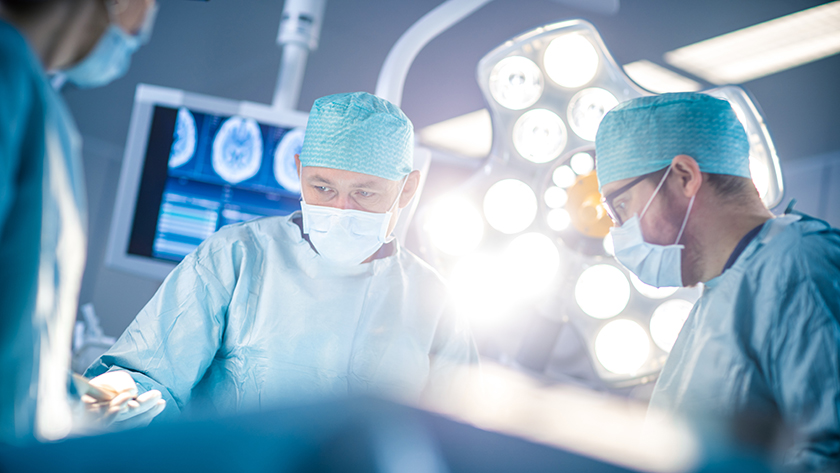More news
- Focus on industrial: Powering the energy industry during extreme heat
- Focus on powder coatings: The coatings industry’s transition to PFAS/PTFE-free solut...
- “We see sustainability as a purpose, as a reason for doing business” – P...
- Focus on industrial: High-performance coating protects tanks at biopolymer production plan...
- Focus on powder coatings: Novel high-speed crosslinking technology

State-of-the-art antimicrobial technology represents a paradigm shift in the prevention and treatment of surgical infections. Here, Arjun Luthra, BioInteractions, discusses the potential presented by antimicrobial coatings and the challenges stunting their use
In the past century, modern medicine has broken countless barriers toward a safer, more effective healthcare protocol. One of the most important discoveries has been antibiotics. Unfortunately, the widespread use of antibiotics has led to growing antibiotic resistance.
According to the European Centre for Disease Prevention and Control, more than 4 million people acquire a healthcare-associated infection (HCAI) each year, resulting in 37,000 deaths. Combatting HCAIs is a significant problem for the healthcare sector globally. HCAIs are the sixth leading cause of death in Western countries. However, treating these infections with antibiotics is lowering the effectiveness of the treatments and the public trust in medicine. Researchers have pinpointed the cause of most of these infections: bacteria-infested surfaces inside of hospitals. There is an identified need to protect surfaces from germs and microbes by using antimicrobial coatings.
An antimicrobial coating is an application of a chemical agent on a surface that can stop the growth of disease-causing micro-organisms. Apart from increasing the surface’s durability, appearance and corrosion resistance, these coatings also protect from harmful disease-causing microbes. Coat medical equipment with an antimicrobial solution and it can become up to 99.999% sterile, significantly reducing the risk of infection for the patients. Antimicrobial coatings stick to the surface they are applied on and remain effective for a period, defining them as one of the best options to fight bacteria in a medical environment.
State-of-the-art antimicrobial coatings and their uses
Everything is susceptible to microbes: surfaces, healthcare devices, equipment, walls, textiles. The list is almost endless. From these surfaces, microbes find their way to humans. Unfortunately, strict hygiene regimes and existing disinfectants have limited efficacy and require a considerable level of maintenance to reduce the risk of infection for prolonged time periods.
New developments are bringing to light state-of-the-art antimicrobial coatings that offer a new way to combat infections more effectively, efficiently and for longer periods of time. These coatings are proven to provide monoclonal protection, killing a broad spectrum of gram-positive and gram-negative bacteria and enveloped and non-enveloped viruses, including E.coli, MRSA, influenza, vaccinae, adenovirus, norovirus and SARS-CoV-2. Our TridAnt antimicrobial coating, for example, is suitable for skin protection and most other surfaces including woven and non-woven fabrics, such as metals (nitinol) as well as polymers (polycarbonate and polyurethanes).
The new antimicrobial technology is non-leaching and, therefore, completely safe to use in all environments and even for implants inside the human body including Class III medical devices. Its active components target microbes (prokaryotic cells) and have reduced risk to human cells, unlike previous technologies. For the first time, medical device technology can kill enveloped and non-enveloped viruses, gram-positive and gram-negative bacteria. In addition, it can prevent the formation of biofilms for long-periods of time of up to 365 days (as well as safe enough to protect skin for up to 48 hours) without any noticeable reduction in efficacy over time. As a result, antimicrobial-coated medical devices are protected with a highly effective and non-leaching shield for the device’s entire lifetime.

A BioInteractions laboratory employee holds a TridAnt coated surface and a non-coated surface [Photo courtesy of BioInteractions]
Challenging regulations
One of the main factors stunting the widespread use of antimicrobial coatings are current regulations. Under today’s European Union (EU) regulations, for example, the coatings are considered medicines and are therefore tested by the European Medicines Agency (EMA) following the same tests and approval processes for drugs. As a result, regulators want to make sure that any positive effects an antimicrobial coating has are systematic, able to be replicated across the board in different settings and for different patients.
In the US, the use of antimicrobial coatings is more widespread than in the EU. The FDA allows the use of chlorhexidine and silver-based coatings, regardless of them leaching and reducing their effectivity overtime. In the EU, however, this is considered a risk — and regulated.
Thorough testing and aiming for perfection in all medical-adjacent products are especially important not only for patient care, but also to bring about a continued cycle of technology innovation. This current testing method helps hospitals, patients and doctors to be certain that antimicrobial coatings are effective against HCAIs. However, this process can be very long — at times up to years — for technologies ultimately to earn accreditation, which slows down progress. Regulations need to be thorough and effective, but they also must move forward to assist with innovation.
Promising and potential uses in the future
There now is the prospect that biocompatible technology can enhance the function of medical devices by eliminating existing microbes and also prevent the formation of new colonies consistently over extensive periods of time. It represents a paradigm shift in the prevention and treatment of surgical infections.
The future will bring further developments in material sterilisation, bacterial reduction and viral prevention. As a result, antimicrobial coatings will cement themselves as the golden standard of excellence in healthcare, used in all things that go inside the patient and around open wounds. Additionally, they will help prolong the active lifecycle of medical devices, which has a significant economic, health and social care impact.
As time goes on, the focus in the healthcare sector will switch from infection reaction to infection prevention. Once science understands how to prevent infections, we will also be able to stop pandemics and lockdowns and raise the public’s confidence in antibiotics and vaccines.
Author bio
Arjun Luthra is the commercial director at Biointeractions, an R&D company specialising in biomaterial coatings for devices, instruments and implants. The portfolio of multi-action materials confronts chronic challenges such as thrombus formation, infections, device-related complications and other biocompatible challenges.




